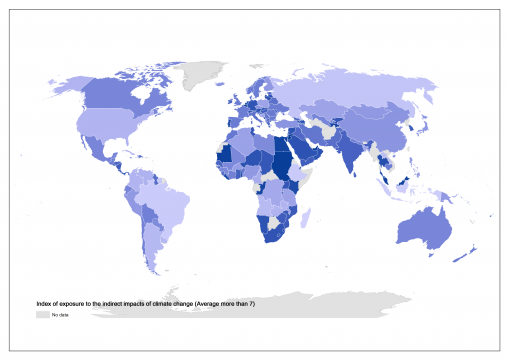The Adaptation without Borders Index of exposure to indirect impacts of climate change


Introduction
Despite several attempts to measure global vulnerability to climate change, at varying levels of complexity and sophistication, none adequately capture how and why countries are likely to experience climate change impacts in reality. That is because they focus exclusively on what we call direct climate change impacts – the result of climate change inside a country’s territory – and the factors that may make those countries susceptible to such changes, or provide them with the capacity to adapt.
However, in reality the world is more complex. Countries are highly interdependent. Countries rely on global markets for access to critical resources. People, species and resources cross borders at an increasing rate and intensity. And all countries are affected by stability and growth in their neighbouring and partner countries around the world, to a greater or lesser extent. This interdependence will influence the way that climate risks play out, and therefore the exposure of countries to climate impacts, including climate impacts in other countries.
Global views of exposure to climate change should therefore take this interdependence into account. It is not enough to measure and perceive climate vulnerability as based on direct climate change impacts only, as implied by the current suite of climate vulnerability indices.
Applying a new conceptual framework, SEI has developed the Adaptation without Borders Index of Exposure*(or AwB Index, for short). The Index puts forward an early version of a framework that will be further developed in future. It explores the characteristics of national economies that expose them to the indirect impacts of climate change via four principle pathways: trade, finance, people and bio-physical, in addition to climate-driven changes in the global context.
It is a crude Index that is subject to the same weaknesses of other indices, including the poor availability of global data and its reliance on certain assumptions to underpin the selection of indicators. The Index should not be used to assess any individual country, but the combination of the different indicators does provoke new questions about what it means to be exposed or vulnerable to climate change.
Our intention is to use the Index to open up new discussions about interdependence and the international dimension of climate risk. Click on the presentation below for an introduction to the Index, and please share your feedback with us as we look to develop the Index further.
*Please note that this name has later been changed to the Transnational Climate Impacts Index.
Click to view Prezi about the AwB project
Tip: click to view the Prezi in full screen mode for a better experience!
(0) Comments
There is no content